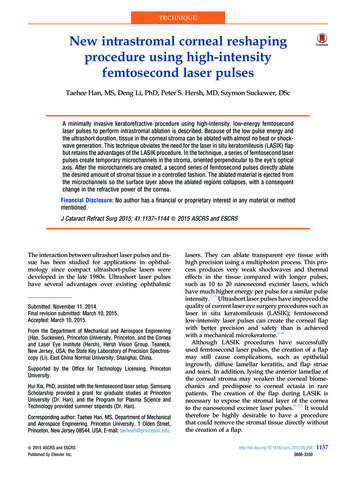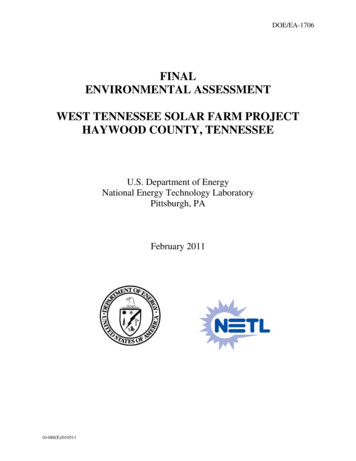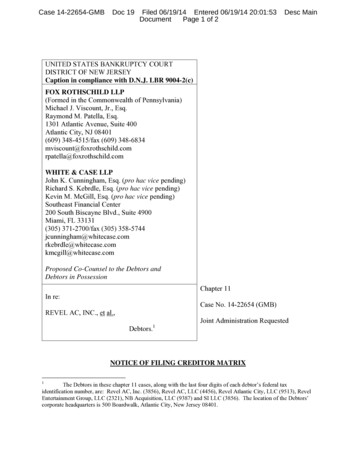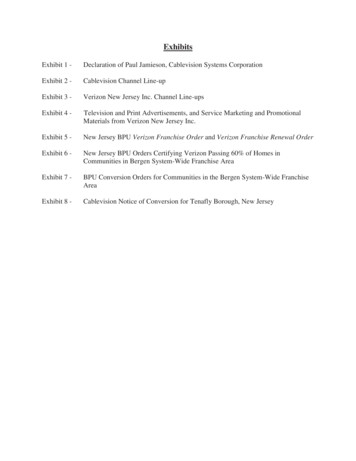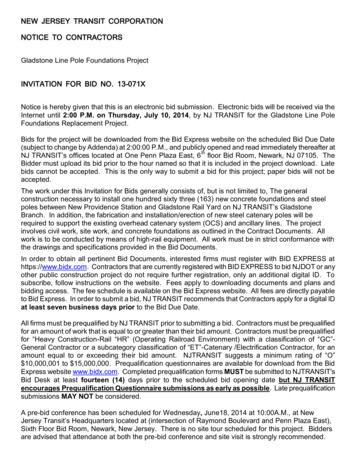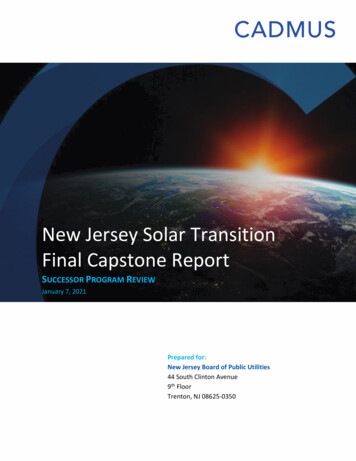
Transcription
New Jersey Solar TransitionFinal Capstone ReportSUCCESSOR PROGRAM REVIEWJanuary 7, 2021Prepared for:New Jersey Board of Public Utilities44 South Clinton Avenue9th FloorTrenton, NJ 08625-0350
Prepared by:The Cadmus Group, LLC
New Jersey Solar Successor ProgramFinal Capstone ReportDisclaimerThis Final Capstone Report dated January 7, 2021, is delivered pursuant to Cadmus’s obligations undera contract with the New Jersey Board of Public Utilities (NJBPU) in connection with the assessment ofa successor solar program for the State. This report is provided “as is” based on information availableas discussed below. The document is provided for information purposes only, and Cadmus and NJBPUdo not provide any representation or warranty, express or implied, as to the accuracy, completeness,reliability, or timeliness of any of the content or information contained herein. Cadmus expresslydisclaims all liability associated with NJBPU’s use of the report or information included therein. Anyforecasts or projections contained herein are estimates only. This report does not provide a legalinterpretation of any New Jersey statutes, regulations, or policies, nor should it be taken as anindication or direction of any future decisions by NJBPU. In no event will Cadmus or NJBPU be liable toanyone for any decision made or action in reliance on the information in the report or for any special,consequential, or similar damages, even if advised on the possibility of such damages.i
New Jersey Solar Successor ProgramFinal Capstone ReportTable of Contents1. Executive Summary.12. Background and Summary of Stakeholder Engagement. 42.1. Overview of the CEA and Resulting Closure of the SREC Market . 42.2. Overview of Stakeholder Engagement in the Solar Transition . 52.3. Phase 1. Transition Incentive . 62.4. Phase 2. Successor Program . 93. Incentive Option Development. 173.1. Identify Successor Program Incentive Design Criteria . 173.2. Review Range of Potential Design Options. 173.3. Incentive Types Chosen . 184. Successor Program Modeling Overview . 284.1. Project Model . 294.2. Market Model Overview . 554.3. Forecasting Capacity Growth . 574.4. Transition Period Modeling . 644.5. Legacy SREC Tranche Cost Derivation . 684.6. TREC Tranche Cost Derivation . 704.7. Successor Tranche Cost Derivation . 714.8. Other Market Modeling and Assumptions . 715. Analysis and Modeling of Successor Program . 805.1. Assessing Minimum Successor Program Incentive Levels . 805.2. Modeling Changes for the Sensitivity Scenario . 885.3. Successor Program Capacity Targets . 935.4. Cost Cap Considerations . 976. Considerations and Recommendations . 1006.1. Selected Material Considerations . 1006.2. Recommendations . 101ii
New Jersey Solar Successor ProgramFinal Capstone ReportAppendicesAppendix A.Examples of Installed Cost Histograms . A-1Appendix B.Installed Capacity Growth by Broad SAM Case . B-1Appendix C.Azimuths by Broad SAM Case .C-1Appendix D.OpenEI Retail Electricity Prices . D-1Appendix E.Large C&I Retail Electricity Prices . E-1Appendix F.Community Solar Rates . F-1TablesTable 1. Summary of Stakeholder Engagement Activities . 5Table 2. Translating Original Solar Transition Principles into Successor Program Design Criteria . 7Table 3. Translating Higher Priority Stakeholder Objectives into Primary SuccessorProgram Design Criteria . 7Table 4. Translating Other Priority Stakeholder Objectives into Secondary SuccessorProgram Design Criteria . 8Table 5. Potential Successor Program Policy Paths . 9Table 6. SW #3 Summary of Policy Design Issue and Option Preferences . 10Table 7. Potential Incentive Types . 18Table 8. SAM Financial Models . 29Table 9. Derivation of SAM Cases – Initial Groupings . 32Table 10. Derivation of SAM Cases – Reduced Grouping . 33Table 11. Community Solar Projects by Installation Type . 33Table 12. Final List of Modeled SAM Cases with Descriptions . 35Table 13. Modeled Capacity. 37Table 14. Modeled Orientation by Broad Project Type . 39Table 15. Year 1 SEPs and Capacity Factors by Broad Project Type . 40Table 16. Installed Cost Outlier Ranges . 42Table 17. Installed Costs by SAM Case. 44Table 18. Operating Expenditures ( /Year) . 47Table 19. O&M Fee and Insurance Costs . 48Table 20. Draft Capstone / Base Scenario Financial Parameters for PPA Projects . 49iii
New Jersey Solar Successor ProgramFinal Capstone ReportTable 21. Draft Capstone / Base Scenario Financial Parameters for DO Projects . 49Table 22. Observations of Historical Installations by SAM Case . 59Table 23. Recommended Growth Rates by SAM Case . 60Table 24. Total Capacity Needed from Successor Tranche . 64Table 25. Paring Down of Transition Incentive Pipeline List . 67Table 26. TREC Tranche SEPs and TREC Factors . 71Table 27. Derivation of Combined Wholesale and Energy Prices . 73Table 28. Modeled Terms of OSW Solicitations. 78Table 29. Base Case OSW Deployments . 78Table 30. Comparison of Minimum Incentives among SAM Cases . 82Table 31. Comparison of Minimum Incentives Over Time . 83Table 32. Comparison of Minimum Incentives by Incentive Term . 84Table 33. Breakdown of SAM Case Capacity within Each EDC . 85Table 34. Share of SAM Case Capacity Across EDCs . 85Table 35. Rate/Incentive Ranges by EDC and Service Class . 86Table 36. Comparison of Minimum Incentives by Incentive Type . 88Table 37. Sensitivity Scenario: Comparison of PBIs for Levered vs. Unlevered Projects . 93Table 38. Top-Down Capacity Re-Allocation Example . 97Table 39. Histograms of Installed Costs .A-1Table 40. OpenEI Retail Electricity Prices Via SAM . D-1Table 41. ACE Large C&I Tariff . E-1Table 42. ACE Large C&I Energy Charge Derivation . E-2Table 43. JCPL Large C&I Tariff . E-3Table 44. JCPL Large C&I Energy Charge Derivation . E-3Table 45. PSEG Large C&I Tariff . E-4Table 46. PSEG Large C&I Energy Charge Derivation . E-4Table 47. RECO Large C&I Tariff . E-5Table 48. RECO Large C&I Energy Charge Derivation . E-6Table 49. ACE Community Solar Rate . F-1Table 50. JCPL Community Solar Rate. F-2Table 51. PSEG Community Solar Rate . F-3Table 52. RECO Community Solar Rate . F-4iv
New Jersey Solar Successor ProgramFinal Capstone ReportFiguresFigure 1. Residential Switch to DO and Overall Decline . 58Figure 2. Decline in Legacy SREC Capacity Over Time . 63Figure 3. Estimated Time to Completion Based on Installed Projects . 66Figure 4. Rules for Assignment to Solar Tranches . 68Figure 5. Historical SREC Prices . 70Figure 6. EIA Forecast Wholesale Prices . 72Figure 7. Historical Compliance Retail Volume Sales . 75Figure 8. Statewide Bundled Retail Electricity Prices, EY 2001-LTM Nov. 2019 . 76Figure 9. Residential and Commercial Bundled Rates, EY 2009-LTM Nov. 2019 . 76Figure 10. EIA Forecast Retail Prices . 77Figure 11. Class I REC Prices . 79Figure 12. Target Successor Program Capacity Annual Additions . 94Figure 13. Forecast Successor Program Installed Capacity by Broad Project Type . 95Figure 14. Comparison of 2019 EMP Target and Successor Program Modeled Installation . 96Figure 15. Total Amount Paid for Electricity . 98Figure 16. Adjustments to Baseline Electricity Cost . 98Figure 17. Class I REC Costs by Program . 99Figure 18. Annual Installations. B-1Figure 19. Rolling 12-Month Average Monthly Installations (Jan. 2018-Dec. 2019) . B-2Figure 20. Distributions of Adjusted Azimuths . C-1v
New Jersey Solar Successor ProgramFinal Capstone CEPNRELNYSERDAO&MOOSOpexORECOSWPBIPILOTPJM OTRECAtlantic City ElectricAnnual Technology BaselineBase Residual AuctionBehind-the–MeterCommercial and IndustrialCompound Annual Growth RateCapital ExpendituresClean Energy Act of 2018Direct OwnershipElectric Distribution CompanyU.S. Energy Information AdministrationEastern Mid-Atlantic Area CouncilEnergy Master PlanEngineering, procurement, and constructionFederal Energy Regulatory CommissionFront-of-the-MeterIntegrated Energy PlanInverter Load RatioInternal Rate of ReturnJersey Central Power & LightLow-to Moderate-IncomeLocational Marginal PriceLoad-Serving EntityMinimum Offer Price RuleNew Jersey Board of Public UtilitiesNew Jersey’s Clean Energy Program National Renewable Energy LaboratoryNew York State Energy Research & Development AuthorityOperations and MaintenanceOut-of-StateOperating ExpensesOffshore Wind Renewable Energy CertificateOffshore WindPerformance-Based IncentivePayment in Lieu of TaxesPJM Generation Attribute Tracking SystemPower Purchase AgreementPublic Service Electric and Gas CompanyPermission to OperatePhotovoltaicRenewable Energy CreditRockland Electric CompanyRenewable Portfolio StandardSolar Alternative Compliance PaymentSystem Advisor ModelSpecific Energy ProductionSolar Renewable Energy CertificateSREC Registration ProgramStakeholder WorkshopTypical Meteorological YearThird-Party OwnershipTransition Renewable Energy Certificatevi
New Jersey Solar Successor ProgramFinal Capstone Report1. Executive SummaryNew Jersey’s Clean Energy Act (CEA) of 2018 directed the New Jersey Board of Public Utilities (NJBPU) todevelop a new program “to encourage the continued efficient and orderly development of solarrenewable energy generating sources throughout the State.” As part of the CEA, NJBPU was required toprepare a report to the Governor and Legislature of New Jersey to recommend how best to replace theexisting Solar Renewable Energy Certificate (SREC) market with a new solar incentive program thatwould deliver improved solar performance at a reduced price. In order to minimize market disruption,NJBPU conducted this transition (referred to as the Solar Transition) in two phases: first, an interimTransition Incentive Program established in December 2019 and took effect in May 2020; second, along-term successor solar program (Successor Program), which is the focus of this report. 1 NJBPUretained the Cadmus Group, LLC (Cadmus) to help conduct an extensive stakeholder-driven review ofNew Jersey’s solar policies and to prepare this report.A draft of this Capstone Report, dated August 11, 2020, was released to stakeholders for review andfeedback, followed by questions posed by NJBPU Staff for stakeholder feedback to the report.Stakeholder meetings were held on August 17 and August 20, 2020, to review the report’s modelingassumptions and recommendations. Written stakeholder comments were accepted until September 8,2020. As a result of this stakeholder process and additional research, Cadmus amended certain parts ofthis report and ran modeling sensitivities on assumptions identified by stakeholders. Modeling resultspresented in this Capstone Report (see Section 5.1) are therefore sometimes presented in twoscenarios: a “Base Scenario” that reflects the original assumptions used by Cadmus, and a “SensitivityScenario” showing the impact of cumulative changes in assumptions recommended by variousstakeholders. Cadmus recommends that the Board consider the Base Scenario modeling results as abaseline and adjust variables as appropriate based on further stakeholder feedback and initiatives thatCadmus has proposed throughout this document.This report reviews and analyzes options for the Successor Program. The report is organ
SACP Solar Alternative Compliance Payment SAM System Advisor Model SEP Specific Energy Production SREC Solar Renewable Energy Certificate SRP SREC Registration Program SW Stakeholder Workshop TMY Typical Meteorological Year TPO Third-Par



